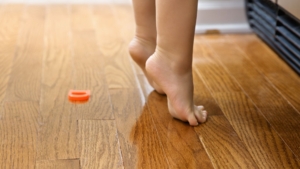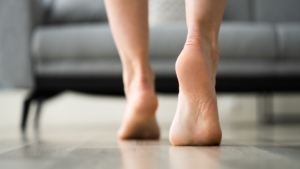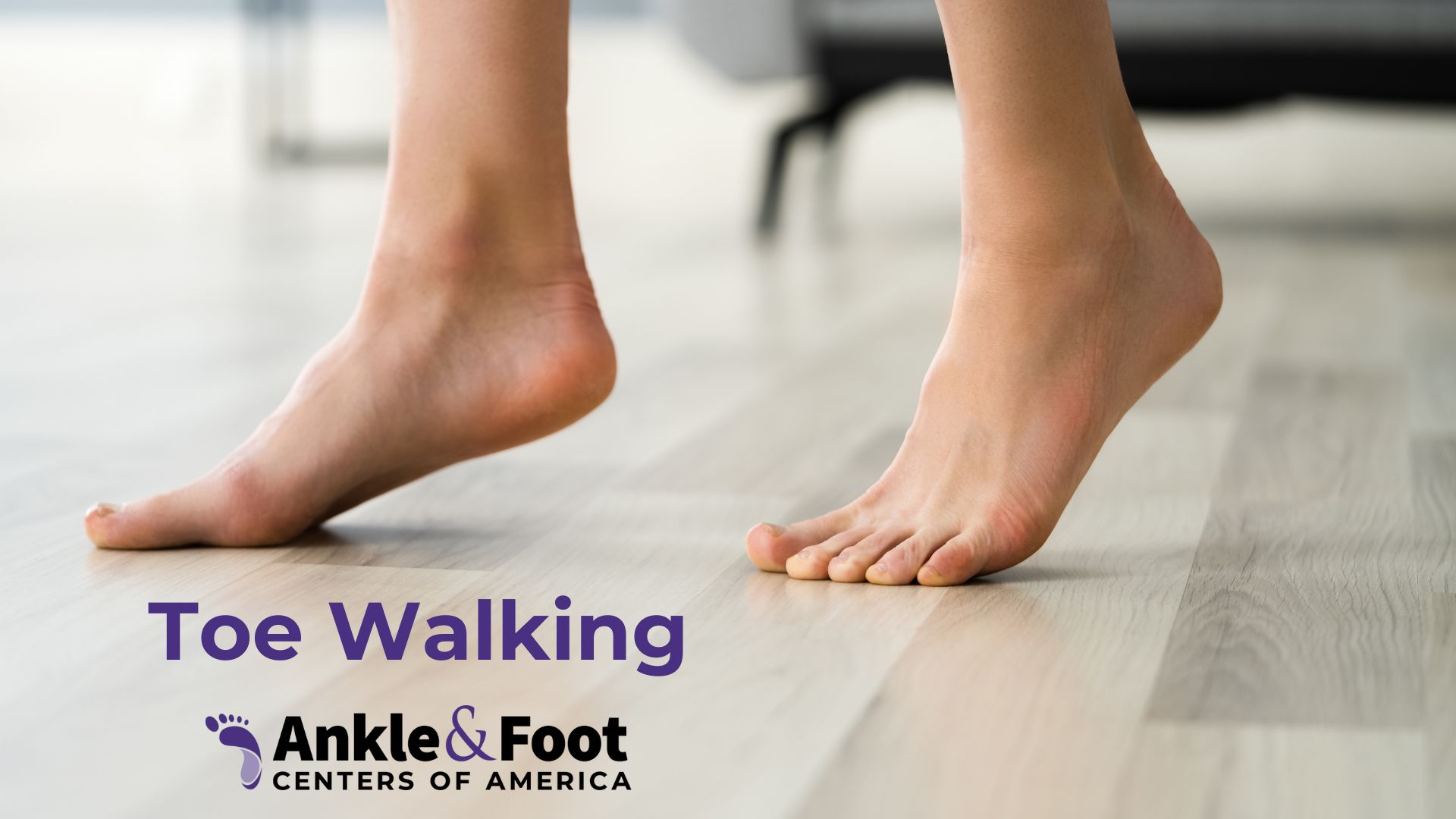Have you ever noticed your child walking on their tiptoes, seemingly without a care in the world? While this may seem like an adorable quirk, toe walking, or “toe walker” behavior, is actually a common early developmental stage in children. In this blog post, we’ll dive deeper into the world of toe walking, discussing the differences between normal developmental toe walking and persistent toe walker tendencies, potential causes, symptoms, diagnosis, treatment options, and prevention strategies.
Short Summary
- Understanding toe walking involves recognizing the normal developmental stage of children learning to walk on their toes, as opposed to persistent toe walking which may suggest potential underlying issues.
- Early recognition of symptoms and signs is important for appropriate care and treatment, with causes ranging from idiopathic conditions to muscular or neurological issues.
- Proper preventive measures and management strategies are essential for promoting healthy foot development in children with toe walking.
Understanding Toe Walking
Toe walking is a condition where the heel of the foot touches the ground minimally, or not at all. As a result, the majority of weight is placed on the toes. Toe walking in children is a frequent early developmental stage as they learn to walk, and it’s common for a child to walk on their toes during this phase.
However, when a child continues to walk on their toes or the balls of their feet without their heels touching the ground beyond the usual age range, it’s called persistent toe walking. Persistent toe walking may indicate potential underlying issues, including sensory challenges, medical conditions, or idiopathic toe walking, which can affect the heel bone and other parts of the foot.
Early Development
 Early toe walking is a regular early developmental phase in children, and most children stop toe walking as they grow older. Toe walking in toddlers is generally considered to be a common occurrence, and children who toe walk as toddlers will typically transition to a heel-toe walking pattern as they progress in age.
Early toe walking is a regular early developmental phase in children, and most children stop toe walking as they grow older. Toe walking in toddlers is generally considered to be a common occurrence, and children who toe walk as toddlers will typically transition to a heel-toe walking pattern as they progress in age.
Once they have developed the ability to walk on their feet, most children will discontinue foot walking without any parental or medical intervention. Early toe walking is a common aspect of a child’s growth and typically resolves independently, meaning that most children will stop toe walking on their own.
Persistent Toe Walking
Toe walking becomes a concern in older toe walking children, typically those aged 5 and above, as it may be associated with underlying medical conditions such as autism spectrum disorder. Parents of children who toe walk may be quite concerned about the long-term implications this walking pattern may have on their future functioning from teenage to adulthood. It is important to take necessary precautions to ensure optimal development potential as early as possible.
Persistent toe walking in older children may signify the presence of underlying medical or sensory issues, and it is important to have toe walking diagnosed by a healthcare professional. If a child persists in walking on their toes beyond the age of three, or is unable to place their heels on the ground, it is recommended that they be evaluated by a health professional who has expertise in evaluating children’s walking, especially if toe walking persists.
Identifying Causes of Toe Walking
There are various potential causes of foot walking, such as:
- Idiopathic toe walking
- Muscular or neurological conditions
- Tightness in the calf muscles
- Sensory processing issues
- Habitual toe walking
Identifying the cause of toe walking is crucial in determining the appropriate treatment plan for your child.
In this section, we’ll delve into the different causes of toe walking and how they might affect your child’s walking pattern.
Idiopathic Toe Walking
 Idiopathic toe walking (ITW) is a condition wherein a child habitually walks on their toes without any associated medical cause. It is believed to be associated with sensory processing difficulties. The term “idiopathic” indicates that the precise cause of heel walking is not known.
Idiopathic toe walking (ITW) is a condition wherein a child habitually walks on their toes without any associated medical cause. It is believed to be associated with sensory processing difficulties. The term “idiopathic” indicates that the precise cause of heel walking is not known.
Children with idiopathic toe walking:
- Possess the capacity to voluntarily walk with the customary heel-toe pattern
- Prefer to walk on their tip toes
- Physical examinations and neurological assessments are unremarkable in children with idiopathic toe walking.
Specific tests, including X-rays, CT and MRI scans, as well as nerve and muscle tests involving electrode patches or needles, are generally not requested for idiopathic toe walking.
Medical Conditions
Certain medical conditions may be responsible for persistent toe walking. For example, cerebral palsy and GLUT1 Deficiency Syndrome are two medical conditions that may be associated with persistent toe walking. Toe walking associated with cerebral palsy may be a result of diminished plantarflexion, which may be limited to toe walking.
Toe walking is a common sign of GLUT1 Deficiency Syndrome. It is important to be aware of this symptom when diagnosing the condition.
Sensory Challenges
Sensory challenges may also be linked to toe walking. Some factors that can contribute to toe walking include:
- Vestibular dysfunction: a disorder of the inner ear that affects balance and coordination, potentially leading to toe walking
- Tactile defensiveness: an aversion or heightened sensitivity to certain textures or touch sensations
- Sensory processing issues: difficulties in processing and responding to sensory information
These factors can all play a role in toe walking.
Tactile defensiveness is an over-sensitivity to touch, which can lead to a child being uncomfortable with certain textures or fabrics and may result in toe walking as a coping mechanism. Sensory processing issues refer to difficulties in processing sensory information, which can result in impaired motor skills, coordination, and balance, consequently leading to toe walking.
Recognizing Symptoms and Signs
Awareness of the symptoms and signs of foot walking is essential for early detection and intervention. Indications of toe walking may include an inability to walk flat-footed, issues wearing shoes, and impediments to engaging in sports or recreational activities.
By observing your child’s walking pattern and being vigilant for any potential signs of toe walking, you can ensure that they receive the appropriate care and treatment.
Physical Appearance
The physical manifestation of toe walking is a gait pattern characterized by walking on the tiptoes and having tightened calf muscles. This walking pattern can be easily observed, and if you notice your child consistently walking on their tiptoes, it’s essential to consult with a healthcare professional to determine the cause and appropriate treatment plan.
Early intervention is key to helping children with toe walking, as it can help reduce the risk of injury.
Impact on Daily Activities
Toe walking can impact daily activities, making it difficult for children to participate in sports or recreational activities and affecting their overall quality of life. It can also cause issues wearing shoes, as the unusual walking pattern may cause discomfort or difficulty fitting into standard footwear.
Ensuring that your child receives the proper diagnosis and treatment can help alleviate these challenges and improve their daily functioning.
Diagnosis Process
The process of diagnosing toe walking typically involves:
- A comprehensive physical examination
- Review of medical history
- Evaluation of the child’s gait, muscle strength, and range of motion
- Additional tests, such as X-rays or neurological evaluations, to rule out any possible underlying conditions
It is imperative to consult with a healthcare professional for an accurate diagnosis and suitable treatment plan. Some healthcare professionals you may consider consulting include:
- Family physician
- Neurologist
- Orthopedic surgeon
- Pediatrician
- Physical therapist
- Physiotherapist
- Podiatrist
Medical History Review
In the diagnosis process of toe walking, the medical history review entails evaluating the patient’s past medical records, including any prior diagnoses, treatments, or surgeries related to the condition. It also incorporates assessing the patient’s developmental history, such as motor milestones, and any other pertinent medical conditions or family history that may contribute to toe walking.
A child’s medical history should be devoid of any neurological, orthopedic, or neuro-psychiatric conditions, including other gait abnormalities.
Physical Examination
During the physical examination, the healthcare provider will observe the child’s walking pattern and check for muscle tightness or neurological issues. They may also utilize tests such as gait analysis and electromyography (EMG) to assess muscle tightness and potential neurological problems.
These examinations provide valuable information to determine the cause of toe walking and the most appropriate treatment options for your child.
Further Testing
 Depending on the results of the medical history review and physical examination, further testing may be necessary to determine the cause of toe walking. An electromyography (EMG) test may be conducted to assess responses in the pertinent muscle.
Depending on the results of the medical history review and physical examination, further testing may be necessary to determine the cause of toe walking. An electromyography (EMG) test may be conducted to assess responses in the pertinent muscle.
Suspicion of conditions such as autism or cerebral palsy can call for neurological testing. In such cases, a doctor will order the tests. These additional tests can help pinpoint the exact cause of toe walking, allowing healthcare professionals to create an effective treatment plan tailored to your child’s needs.
Treatment Options for Toe Walkers
There are various treatment options available for children with toe walking, ranging from conservative treatments to surgical interventions. The choice of treatment depends on the cause of toe walking and the severity of the condition.
In this section, we will explore the different options to treat foot walking and their effectiveness in addressing this issue.
Conservative Treatments
Conservative treatments for toe walking may include physical therapy and braces. Physical therapy involves exercises and stretches to enhance the strength and flexibility of the leg and foot muscles. Braces, such as ankle-foot orthoses (AFOs), dynamic AFOs, and hinged AFOs, can be used to maintain the feet in the correct position while walking, promoting a normal gait.
Other conservative treatments may include the use of orthotics, botulinum toxin injections, and gentle stretching of the leg and foot muscles. These treatments can help improve walking patterns in children with toe walking and address any underlying issues.
Surgical Interventions
In severe cases of toe walking, surgical interventions such as Achilles tendon lengthening may be necessary. This surgical procedure is intended to improve range of motion and facilitate better functioning of the foot and ankle by lengthening the tendons.
Following surgery, the child may need to wear short leg walking casts for 4 to 6 weeks to aid in the healing process. Physical therapy is typically recommended after both surgical and nonsurgical treatment to assist the patient in developing a more consistent flat-footed gait.
Prevention and Management
Prevention and management of toe walking involve a combination of strategies, including regular check-ups, proper footwear, and parental support. By being proactive in addressing toe walking concerns, parents can help ensure their child’s healthy foot development and overall well-being.
Regular Check-ups
Regular check-ups with a pediatrician are crucial in monitoring and addressing foot walking concerns. These check-ups allow healthcare professionals to observe the condition and assess the progress of treatment. During check-ups, reflexes, muscle strength, and sensations in the legs and feet can be evaluated.
Regular check-ups can also help detect any potential limitations or complications and make necessary modifications to the treatment plan.
Proper Footwear
Proper footwear is essential in the prevention and management of toe walking. Shoes should have the following features:
- Support and stability
- Firm heel counter
- Wide toe box
- Flexible sole
- Lightweight
- Low heel
Wearing the correct type of shoes can help promote a regular walking gait, protect the feet from harm, and provide stability while walking.
Parental Support
Parental support plays a crucial role in the prevention and management of toe walking. By actively participating in:
- decision-making
- treatment adherence
- progress tracking
- providing emotional support
Parents can help their child overcome foot walking challenges. Encouraging stretching exercises and addressing sensory challenges are important aspects of parental support.
By working closely with healthcare professionals and implementing the recommended treatment strategies, parents can help their child achieve a healthy walking pattern as the child walks.
Summary and Conclusion
In conclusion, toe walking is a common early developmental stage in children that usually resolves on its own. However, persistent foot walking can indicate underlying issues that require medical attention. Understanding the causes, symptoms, and treatment options is essential in ensuring your child’s healthy foot development. With regular check-ups, proper footwear, and parental support, you can help your child overcome foot walking challenges and enjoy a lifetime of healthy walking.
Toe walking, while common in early childhood, can continue into later years due to various causes, ranging from habit to neurological or muscular disorders. Diagnosis involves thorough physical examinations and, in some cases, detailed neurological and orthopedic assessments. Depending on the underlying cause and the age of the individual, treatments can span physical therapy, orthotic devices, or surgical intervention.
Adult toe walkers face unique challenges, but with appropriate management and support, they can lead fulfilling lives. Early detection through routine pediatric check-ups, coupled with home interventions like calf stretching exercises, can help mitigate the persistence of toe walking.
Whether you’re a concerned parent, a healthcare provider, or someone who experiences toe walking, we hope this comprehensive guide has provided valuable insights into this intriguing yet complex world of toe walking.
Frequently Asked Questions
What is a toe Walker?
Toe walking is a pattern of walking in which a child walks on the balls of their feet, with no contact between the heels and ground. It is commonly seen in children who are learning to walk and can last until the age of two, after which most children outgrow the pattern and begin to walk with a normal heel-to-toe pattern.
Toe walking can be a cause for concern for parents, as it can lead to issues with balance and coordination, as well as potential long-term problems with the feet and legs. It is important to consult a doctor if you have a medical condition.
Is toe walking an ADHD thing?
Studies have found a significant connection between toe walking and children with ADHD, suggesting that toe walking could be linked to the condition.
Further research is needed to fully understand the relationship.
Does toe walking need to be corrected?
Though toe-walking is common in young children and isn’t usually a cause for concern, if your child continues to walk on their tiptoes after the age of 2, it may be an indication of a medical condition that should be addressed.
If your child is toe-walking, it’s important to talk to your pediatrician to determine the cause and get the appropriate treatment. They may refer you to a specialist for further evaluation.
Treatment for toe-walking may include physical therapy, stretching exercises, and orthotics. In some cases, surgery may be necessary.
Is toe walking a gait abnormality?
Yes, toe walking is a gait abnormality, especially in young children who are just starting to walk, which usually resolves on its own without intervention.
What is toe walking a symptom of?
Toe-walking can be an indication of various underlying conditions, such as cerebral palsy, congenital Achilles tendon contracture, Duchenne Muscular Dystrophy, autism spectrum disorder, and other myopathic or neuropathic conditions.
As long as your child is growing and developing normally, however, toe walking is unlikely to be a cause for concern.
References
For further exploration of the topic, the following resources provide comprehensive information on toe walking and related conditions:




